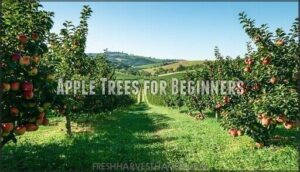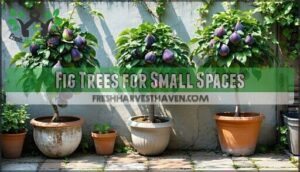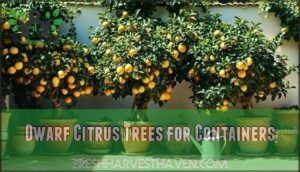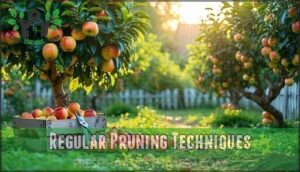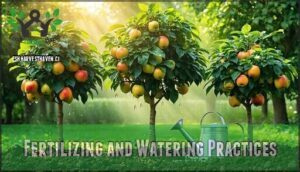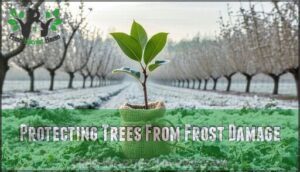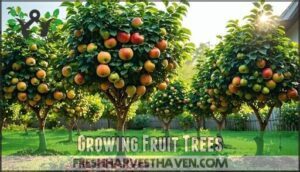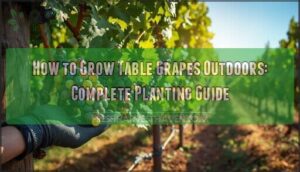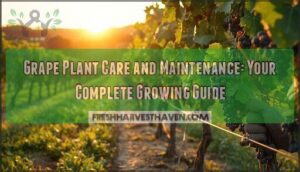This site is supported by our readers. We may earn a commission, at no cost to you, if you purchase through links.
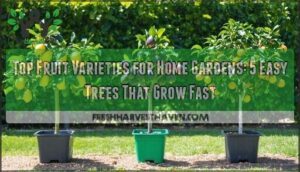 You’ll find the top fruit varieties for home gardens include dwarf Meyer lemons, figs, and pomegranates that adapt well to containers and small spaces.
You’ll find the top fruit varieties for home gardens include dwarf Meyer lemons, figs, and pomegranates that adapt well to containers and small spaces.
These fast-growing trees produce full-sized fruit within 2-3 years, making them perfect for beginners.
Apple trees offer reliable harvests in most climates, while citrus varieties like calamondin thrive indoors during winter months.
American persimmons provide unique flavors and exceptional cold tolerance.
Each variety requires minimal maintenance once established, focusing on proper watering and annual pruning.
The secret lies in matching your climate zone with the right rootstock selection to ensure a healthy and thriving tree, and this is a key factor in the success of your home garden, including the use of proper watering.
Table Of Contents
- Key Takeaways
- Choosing Fruit Trees
- Easy Fruit Trees
- Top Fruit Varieties
- Fruit Tree Care Tips
- Growing Fruit Trees
- Frequently Asked Questions (FAQs)
- What is the best fruit to grow at home?
- What is the easiest fruit to grow in a raised bed?
- What is the best fruit to grow for beginners?
- What is the easiest fruit to grow inside?
- What are the best fruit trees to grow?
- Which fruit tree is best for a new gardener?
- What are some easy fruits to grow?
- How do I choose the best fruit trees to grow?
- Which fruit tree is best for beginners?
- Are fruit trees easy to grow?
- Conclusion
Key Takeaways
- You’ll get the fastest results with dwarf varieties like Meyer lemons, figs, and pomegranates that produce full-sized fruit within 2-3 years and adapt perfectly to containers or small spaces.
- You can grow citrus trees year-round by choosing cold-tolerant varieties like Meyer lemons and calamondin that thrive indoors during winter months while continuing to produce fruit.
- You’ll ensure success by matching your USDA hardiness zone with disease-resistant varieties and selecting proper rootstock that controls tree size while boosting resistance to soil problems.
- You’ll minimize maintenance by choosing self-pollinating options like figs and certain apple varieties that don’t require multiple trees for fruit production, plus focus on consistent watering and annual pruning.
Choosing Fruit Trees
When choosing fruit trees for your home garden, you’ll need to match varieties to your climate zone and soil conditions.
Perfect plant pairings require matching your local growing conditions with compatible fruit varieties.
Consider dwarf rootstock options to keep trees manageable in smaller spaces while still producing full-sized fruit.
Considering Hardiness Zones
Before planting your dream orchard, you’ll need to check your USDA hardiness zone to verify that fruit varieties can survive your winter temperatures.
Zone specifics determine which trees thrive, while microclimates matter for fine-tuning selections.
Understanding hardiness zone basics is vital for selecting the right trees.
Consider these key factors:
- Frost dates – Know your last spring and first fall frost
- Variety selection – Match chill hour requirements to your climate
- Regional adaptations – Choose locally-proven cultivars
- Climate suitability – Verify minimum temperature tolerance
Understanding Soil Types
Your fruit trees need the right soil foundation to flourish.
Soil pH affects nutrient availability – most home garden fruits prefer 6.0-7.0, while acidic soil lovers like blueberries need 4.5-5.5.
Drainage importance can’t be overstated since waterlogged roots kill trees.
Test your soil first, then add soil amendments like compost to improve structure and fertility for ideal fruit varieties.
Selecting Rootstock for Size Management
Smart rootstock selection can dramatically transform your garden’s fruit-growing potential, determining everything from tree height to harvest success.
Smart rootstock choices unlock your garden’s full potential—controlling size, boosting disease resistance, and ensuring perfect harvests.
Rootstock choices control mature size and adaptability:
- Dwarfing rootstocks keep fruit trees under 8 feet tall
- Disease resistance protects against soil-borne problems
- Grafting compatibility guarantees strong tree development
- Soil adaptation matches your garden’s specific conditions
- Mature size fits available space perfectly
Choose dwarf fruit trees for containers and small yards, while standard rootstocks work best for larger spaces with challenging soil conditions.
Easy Fruit Trees
You’ll find these beginner-friendly fruit trees reward you with delicious harvests without demanding expert gardening skills.
Apple trees, figs, and dwarf citrus varieties adapt well to home gardens and forgive common growing mistakes, making them ideal for those new to gardening with fruit trees.
Apple Trees for Beginners
Anyone can grow delicious apples with the right beginner apple varieties.
Choose disease-resistant options like ‘Liberty’ and ‘Enterprise’ for easier apple tree care. These dwarf fruit trees need full sun and well-draining soil. Plant them 2-3 meters apart for proper airflow, which prevents common apple problems during harvesting apples season.
To guarantee successful growth, beginners should consider varieties with high disease resistance.
| Variety | Benefits |
|---|---|
| Honeycrisp | Self-pollinating, crisp texture |
| Liberty | Disease-resistant, low maintenance |
| Enterprise | Scab-resistant, stores well |
| Jonafree | Mid-season harvest, reliable producer |
| Golden Delicious | Self-fertile, sweet flavor |
Fig Trees for Small Spaces
Container figs transform tiny yards into productive orchards. These compact fruit trees thrive in pots, making small space fruit cultivation achievable for anyone.
- Variety Selection: Choose ‘Little Miss Figgy’ or ‘Fignomenal’ – both stay under 5 feet and produce abundant harvests in containers.
- Pruning Methods: Annual trimming keeps trees 3-6 feet tall while encouraging bushier growth and better fruiting habits.
- Winter Protection: Move containers indoors or shield from frost to guarantee survival in colder zones. Container size matters, so consider pot size requirements to accommodate root growth.
Dwarf Citrus Trees for Containers
Dwarf citrus trees bring tropical flavors to your doorstep through container gardening.
These compact fruit trees thrive in pots, making fresh citrus accessible anywhere.
Choose containers 25-30cm wide for young trees, expanding to 40-50cm as they mature.
Container size directly impacts root development and fruit production.
Dwarf varieties like Meyer lemon and Calamondin need 6-8 hours daily sunlight exposure.
Maintain consistent watering needs without waterlogging.
Follow a fertilizing schedule with citrus-specific nutrients during growing season.
You can find various dwarf varieties for your specific needs.
Monitor for pest control issues like spider mites indoors.
Top Fruit Varieties
You’ll find these five fast-growing fruit varieties perfect for home gardens, whether you’re growing in containers or have limited space.
Each tree offers unique benefits, from the fig’s self-fertility to the Meyer lemon’s cold tolerance, making fruit growing accessible for beginners.
1. Fig Tree Seeds Grow Your Own
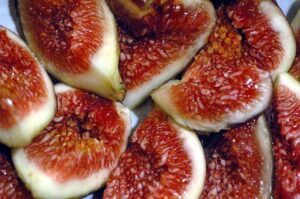
Fig tree cultivation brings gardening enthusiasts incredible satisfaction through simple seed germination and ficus propagation methods.
These versatile fruit tree varieties adapt perfectly to home gardening environments, thriving in containers or garden beds.
Here’s your complete fig growing roadmap:
- Start seeds indoors using quality potting mix and consistent moisture for reliable seed germination
- Provide winter protection by moving container figs indoors when temperatures drop below freezing
- Master indoor growing techniques with bright windows and proper fruit tree care including regular fruit tree pruning
2. Dwarf Meyer Lemon Tree Gift
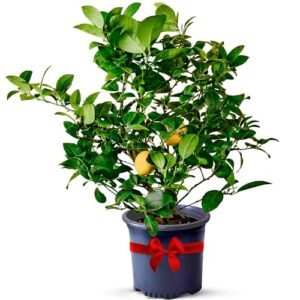
Meyer lemon trees make perfect gifts for any home gardener. These dwarf varieties thrive in containers, bringing fresh citrus indoors during winter. You’ll love their sweet, thin-skinned fruit that’s ready to harvest year-round.
Dwarf varieties are suited for USDA hardiness zones 8-11.
| Feature | Details |
|---|---|
| Size | 4-6 feet tall in containers |
| Hardiness | Zones 9-11 (container anywhere) |
| Fruit Time | 6-12 months to ripen |
| Care Level | Beginner-friendly |
| Special Traits | Self-pollinating, fragrant blooms |
Container citrus growing lets you control soil conditions and move trees indoors when temperatures drop. Meyer lemon flavor is sweeter than regular lemons, making them ideal for cooking and eating fresh.
Dwarf variety benefits include easier harvesting and space efficiency. Gifting lemon trees creates lasting memories – recipients can enjoy homegrown fruit for years. These citrus trees adapt well to home gardening conditions with proper lemon tree care.
3. Calamondin Tree Live Plant Gift
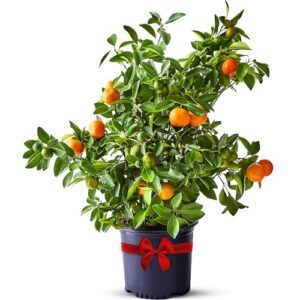
Calamondin trees pack citrus punch in compact packages, making them perfect container fruit companions.
These citrus trees blend tangerine and kumquat genetics, creating unique Calamondin Hybrid Varieties that adapt well to indoor growing conditions.
- Calamondin Flavor Profile: Tart-sweet taste perfect for marmalades, cocktails, and Asian cuisine
- Container Size Matters: 10-15 gallon pots provide adequate root space for healthy growth
- Indoor Calamondin Care: Bright windows, consistent moisture, and monthly fertilizing keep plants thriving year-round
4. Dwarf Pomegranate Live Plant Tree
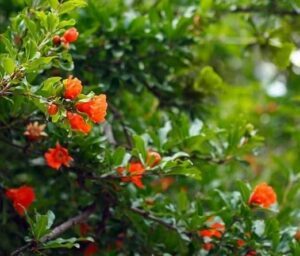
You’ll love how dwarf pomegranate trees pack big flavor into compact spaces.
These fruit trees shine in container growing, reaching just 3-4 feet tall while producing ruby-red gems.
Variety selection matters – choose cold-hardy types for better winter protection.
Their pruning needs stay minimal, making fruit cultivation simple for home gardens.
Unlike larger varieties, dwarf varieties deliver impressive fruit production in surprisingly small packages.
5. American Persimmon Tree Live Plant
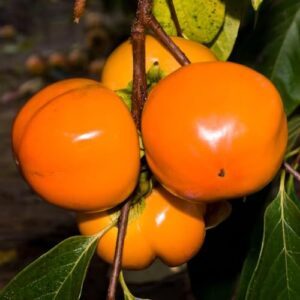
Sweet rewards await when you plant American persimmons in your home gardens.
These hardy fruit trees tolerate various climates and resist most persimmon pests naturally. Japanese persimmon cultivars like ‘Fuyu’ eliminate fruit astringency concerns while providing reliable persimmon pollination.
Their persimmon hardiness spans multiple zones, making fruit cultivation simple. You’ll enjoy fresh persimmons without the pucker factor that deters many gardeners from fruit selection, and with the added benefit of reliable persimmon pollination.
Fruit Tree Care Tips
Once you’ve planted your fruit trees, proper care guarantees they’ll thrive and produce abundant harvests for years to come.
These essential maintenance practices will keep your trees healthy and maximize their fruit production potential.
Regular Pruning Techniques
Your fruit trees’ health depends on proper pruning timing and technique. Late winter pruning during dormancy promotes vigorous spring growth and maximizes fruit production.
Clean, sharp tools prevent disease spread while proper shaping techniques help sunlight reach all branches. Sanitizing tools helps prevent disease transmission.
- Pruning Timing: Cut during late winter before buds break for ideal healing
- Tool Selection: Use bypass pruners for clean cuts and loppers for thicker branches
- Shaping Techniques: Remove crossing branches and open the center for air circulation
Fertilizing and Watering Practices
Balanced slow-release fertilizers support steady growth while organic compost improves garden soil pH naturally.
Apply fruit tree fertilizer twice yearly—spring for nitrogen, fall for phosphorus. Check nutrient needs through soil testing every two years.
Water deeply once weekly, providing 2.5cm including rainfall. Container drainage prevents root rot.
Monitor fruit tree nutrition through leaf color and growth patterns, ensuring steady growth and maintaining proper soil testing.
Protecting Trees From Frost Damage
Winter temperatures can turn your thriving fruit trees into frozen casualties overnight.
You’ll need frost protection methods like tree wrap benefits and microclimate creation around vulnerable plants.
Choose cold hardy varieties when possible, but even these need post-frost care.
Cover young trees with blankets or burlap when temperatures drop below freezing to prevent fruit tree diseases and garden pests.
Consider using protective tree wraps for added insulation.
Growing Fruit Trees
Growing fruit trees successfully starts with choosing the right location and understanding their basic needs.
You’ll want to provide full sun exposure and well-draining soil, while considering cross-pollination requirements and space-saving techniques for smaller gardens.
Full Sun and Well-Draining Soil
Without proper sunlight requirements and soil composition, your fruit trees won’t reach their potential.
Most varieties need six to eight hours of direct sunlight daily and well-draining soil to prevent root rot.
Key drainage solutions for success:
- Garden location – Choose spots away from low-lying areas where water collects
- Soil amendments – Mix compost into heavy clay soils for better drainage
- Microclimates – Consider how buildings affect sunlight patterns throughout the day
Cross-Pollination Needs
Understanding fruit tree pollination helps you choose the right varieties for your home gardens.
Some fruit trees need pollination partners to produce fruit, while others offer self-fertile options.
Check pollen compatibility before planting – apples and pears require different varieties nearby, but peaches and figs don’t.
Proper fruit set depends on matching compatible hybrid varieties within 100 feet of each other.
To guarantee a successful harvest, consider optimal bloom temperatures for your chosen varieties.
Space-Saving Techniques
Smart gardeners maximize small spaces with strategic techniques.
You’ll discover vertical gardening transforms walls into productive fruit zones, while espalier training shapes trees flat against fences.
Container varieties thrive in pots on patios, and hanging baskets work perfectly for strawberries, bringing abundant harvests to compact home gardens.
Frequently Asked Questions (FAQs)
What is the best fruit to grow at home?
Strawberries make the best choice for home gardeners since they’re versatile, easy to grow, and produce fruit in their first year.
You’ll enjoy harvests from containers, hanging baskets, or ground plantings with minimal effort required.
What is the easiest fruit to grow in a raised bed?
Looking for simple success in your raised bed garden?
Strawberries are your best bet for easy fruit growing.
They’re beginner-friendly, thrive in well-draining raised beds, and you’ll harvest fresh berries from June through September with minimal fuss.
What is the best fruit to grow for beginners?
Strawberries are your best bet for beginner fruit growing. They’re incredibly forgiving, produce fruit quickly in their first year, and thrive in containers or raised beds with minimal fuss.
What is the easiest fruit to grow inside?
Good things come in small packages – citrus trees shine as the easiest indoor fruit.
You’ll love growing dwarf ‘Meyer’ lemons or kumquats in containers.
They’re self-fertile, adapt well to indoor conditions, and produce fruit year-round.
What are the best fruit trees to grow?
You’ll find dwarf apple varieties like ‘Honeycrisp’ and citrus trees such as ‘Meyer’ lemons work best for most home growers, offering reliable harvests with manageable care requirements.
Which fruit tree is best for a new gardener?
For beginners, you’ll find strawberries are your best bet since they’re incredibly forgiving and produce fruit in their first year.
They thrive in containers, making them perfect for learning basic fruit-growing skills without major commitment, which is a complete concept for beginners to grasp.
What are some easy fruits to grow?
Strawberries are absolutely foolproof for beginners! You’ll harvest sweet berries within your first year, and they thrive in containers, hanging baskets, or ground with just sunny spots and well-draining soil.
How do I choose the best fruit trees to grow?
Consider your climate zone and available space first. Choose disease-resistant varieties that match your local conditions. Select self-pollinating options like apples or figs for easier maintenance and reliable fruit production.
Which fruit tree is best for beginners?
Figs make excellent starter trees since they’re self-fertile and fast-growing. You’ll get fruit quickly without needing multiple trees for pollination, plus they handle container growing well if space is limited.
Are fruit trees easy to grow?
Fruit trees aren’t difficult but require patience and proper care. You’ll find success with disease-resistant varieties suited to your climate, consistent watering, and basic pruning skills.
Conclusion
Planting your garden becomes a fruitful journey when you choose the right trees.
These top fruit varieties for home gardens transform any space into a productive oasis with minimal effort.
You’ll enjoy fresh harvests within just a few years while building valuable gardening skills.
Each tree adapts well to containers or small yards, making homegrown fruit accessible to every gardener, and allowing you to start your fruit-growing adventure today.
- https://app.tophat.com/register/?tracking_src=website
- https://s3.wp.wsu.edu/uploads/sites/2056/2018/10/Cool-Season-Planting-Chart-for-Companion.pdf
- https://shop.arborday.org/nursery-zones
- https://www.starkbros.com/growing-guide/article/fruit-tree-care-planting-in-your-zone
- https://www.uvm.edu/d10-files/documents/2024-06/ColdhardinessoffruittreesinVT.pdf

